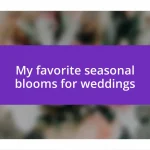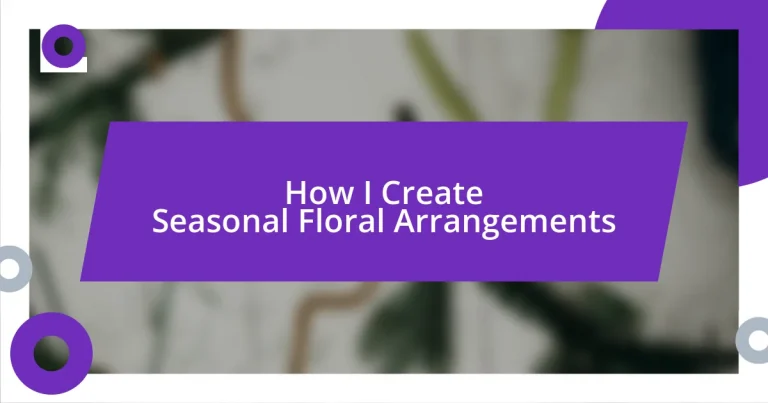Key takeaways:
- Choosing seasonal flowers not only enhances aesthetic appeal but also allows for emotional connections and storytelling through arrangements.
- Color selection, balance, and incorporation of diverse textures and foliage are crucial in creating visually engaging and harmonious floral designs.
- Proper care, hydration, and thoughtful display of arrangements significantly extend the life and impact of floral creations.

Choosing Seasonal Flowers
Choosing seasonal flowers is not just about aesthetics; it’s about connecting with the natural rhythms around us. I remember the first time I picked peonies in early summer, their lush fragrance instantly transported me to childhood gardens. Isn’t it fascinating how certain flowers can evoke such strong memories and emotions?
When selecting seasonal blooms, I often ask myself, “What story do I want to tell with my arrangement?” For instance, in fall, the rich hues of chrysanthemums and dahlias create a warm, inviting atmosphere, reminiscent of cozy gatherings over pumpkin spice lattes. Reflecting on these feelings while choosing my flowers makes each arrangement so much more meaningful.
Additionally, understanding the growing cycles helps me appreciate the blooms even more. Recently, I struggled to find a specific flower out of season and realized how crucial it is to work with what nature provides. This challenge pushed me to discover alternative flowers, leading to unexpected yet delightful combinations. Have you ever encountered a flower that surprised you with its charm?

Understanding Color Palettes
Color palettes can truly transform a floral arrangement, evoking particular moods and feelings. I’ve often found myself drawn to specific colors depending on the season. For instance, during winter, I love using deep reds and greens to create a classic, festive feel. The contrasting colors in arrangements never fail to catch the eye, making the entire display feel alive.
Here’s how I approach color selection:
- Seasonal Inspiration: I consider colors typically associated with the season, like soft pastels in spring or vibrant oranges in summer.
- Emotional Connections: I reflect on what emotions I want the arrangement to spark – calmness, joy, nostalgia – and choose colors accordingly.
- Flower Compatibility: I ensure that the flowers harmonize, avoiding clashes that might distract from the overall aesthetic.
- Personal Touch: Sometimes, I include a favorite color of mine or a shade that reminds me of a cherished memory, adding a personal flair to the arrangement.
Using these principles helps me create arrangements that resonate with both myself and anyone who admires them.

Designing Balanced Arrangements
Designing a balanced floral arrangement feels like conducting a symphony. In my experience, the key is to achieve harmony through proportion and placement. I often start by considering the visual weight of each flower; for example, the heavy blooms of garden roses can balance lighter, more delicate blossoms like baby’s breath. When I’ve arranged flowers, I’ve found that clustering similar shapes or sizes together creates a sense of unity, while also drawing the eye around the bouquet. This is crucial in ensuring that no single element overwhelms the others, creating a cohesive composition.
One of the techniques I use is the “Rule of Thirds.” I imagine the arrangement divided into three sections and aim to distribute flowers and foliage among these sections. When I first experimented with this method, the result was striking. A tall sunflower in one section, for example, elevates the compactness of the roses in another, allowing each flower group to shine while still feeling like part of a larger story. Have you ever noticed how certain arrangements seem to “flow”? That’s the beauty of balance at work.
Maintaining balance is also about scaling elements appropriately. In past projects, I incorporated a mix of both large and small flowers, such as pairing stately lilies with the tiny sprigs of lavender. This contrast not only enhances depth but also creates visual interest. I always remind myself and others, a well-balanced arrangement demands some experimentation and trust in your instincts. Give it a go; you might just discover a new favorite composition!
| Design Principles | Description |
|---|---|
| Symmetry | Mirrored arrangement around a central axis that creates formality. |
| Asymmetry | Balanced arrangement without being identical, fostering creativity and flow. |
| Proportion | Considering the size and scale of flowers relative to each other, ensuring harmony. |
| Color Balance | Using colors that either complement or contrast allows for deeper engagement. |
| Texture Variation | Incorporating different textures adds depth and interest to the arrangement. |

Incorporating Foliage and Textures
Incorporating foliage and various textures into my arrangements is where the magic truly begins. I often turn to lush greenery, such as ferns or eucalyptus, to create a vibrant backdrop that enhances the colors of the flowers. Recently, while working on a spring arrangement, I discovered that the soft, feather-like texture of a certain fern paired beautifully with the sleek petals of tulips, contrasting yet complementing each other perfectly. Have you ever picked up a bouquet and felt a physical reaction to its texture? It’s a powerful experience, and I aim to evoke that feeling.
I like to think of foliage as not just a filler, but as an essential part of the story I’m telling through each arrangement. When I’m selecting greenery, I pay close attention to its form and texture. For instance, accustoming myself with the jagged edges of an ornamental grass can add a striking visual dynamic next to rounded flower blooms, creating a playful tension. In one project, I added cascading ivy that gently draped from the arrangement, bringing movement that almost felt alive, energizing the entire space. Have you considered how foliage shapes the personality of your flowers?
Textures can transform the way someone perceives an arrangement, making it feel richer and more inviting. I often combine different materials, like the soft petals of peonies with the waxy leaves of succulents. The surprise of touching a variety of textures elevates the sensory experience; it invites you to engage with the arrangement on a more intimate level. When arranging, I focus on these contrasts because they tell a story. What story do your textures tell? Each element you choose should contribute to a larger narrative that resonates with you and your audience.

Caring for Fresh Flowers
Caring for fresh flowers is an art that doesn’t end once you’ve arranged them beautifully. I’ve learned that the first step is to cut the stems. A fresh cut at an angle increases the flower’s ability to absorb water. I remember one time, I neglected this tip, and my blooms wilted much faster than I anticipated. It was a lesson learned—the little things make a huge difference.
Watering is essential too, and it’s not just about filling the vase. I make it a habit to change the water every couple of days. Adding a flower food packet not only helps with hydration but can also extend the life of your arrangement. When I forget this step, I notice the petals begin to droop within a week. Have you ever marveled at how a simple change of water can reinvigorate your flowers? It truly is remarkable.
Lastly, placing your arrangement in a suitable environment can make all the difference. I always try to avoid direct sunlight and drafts; these can dehydrate my flowers faster. One sunny afternoon, I set a vase on a windowsill, thinking it would brighten the room. Instead, I returned to find my flowers looking sad and droopy. Now, I keep them in a cooler spot—learning from experience, I’ve come to appreciate how the right conditions can enhance the beauty of my arrangements. How do you ensure your flowers thrive?

Tips for Long Lasting Arrangements
When it comes to creating long-lasting arrangements, I always remember the importance of proper hydration. Using room temperature water prevents shock to the flowers. I’ve had moments where I used cold water in a hurry, only to watch my beloved blooms droop shortly after. It’s a gentle reminder that a little patience goes a long way in preserving their beauty. Have you ever felt anxious and rushed, only to realize that patience pays off?
Another tip is to remove any foliage that sits below the water line. This might seem trivial, but it truly impacts the health of your arrangement. I often find myself meticulously trimming the leaves, and there’s something almost therapeutic in that process. One time, I was so captivated by my arrangement that I overlooked this detail. By the next day, the water was murky and the flowers looked less vibrant. It made me wonder how important it is to pay attention to even the smallest details.
Finally, I like to think about the flowers I choose in terms of compatibility. Mixing flowers with different lifespans can be tricky. I remember creating an arrangement where some blooms wilted faster than others, leaving it looking uneven and lackluster. Since then, I pay attention to their life cycles. Selecting flowers that complement each other by lasting longer together not only keeps the arrangement looking fresh but enhances the overall harmony. How do you curate your flowers to create a balanced experience?

Displaying Your Floral Creations
The way you display your floral masterpieces can elevate the entire experience. Personally, I love placing my arrangements in different areas of my home to see how the lighting and background influence their impact. For example, I once set up a vibrant autumn bouquet on my dining table during a family gathering. The flowers became conversation starters, adding warmth and color to the room, which made it clear that where you showcase your creations really matters.
I’ve experimented with various containers, and it’s fascinating how the right vase can transform the image of your floral arrangement. A rustic ceramic pot worked wonders for a wildflower mix I created; it evoked a sense of countryside charm that perfectly complemented the blooms. Have you noticed how certain shapes or materials enhance the mood of your arrangements? That rustic pot is now one of my favorites because of how it brings a unique character to whatever I place in it.
It’s also essential to give each arrangement enough space to breathe. I once crowded a stunning peony bouquet into a small nook, and it felt lost in its surroundings. Afterward, I realized that allowing my creations room to shine makes all the difference. It’s like giving a piece of art the space it deserves—suddenly, what was once a mere arrangement becomes a focal point that draws the eye and lifts the spirit. How do you ensure your flowers have the space they need to truly flourish?














